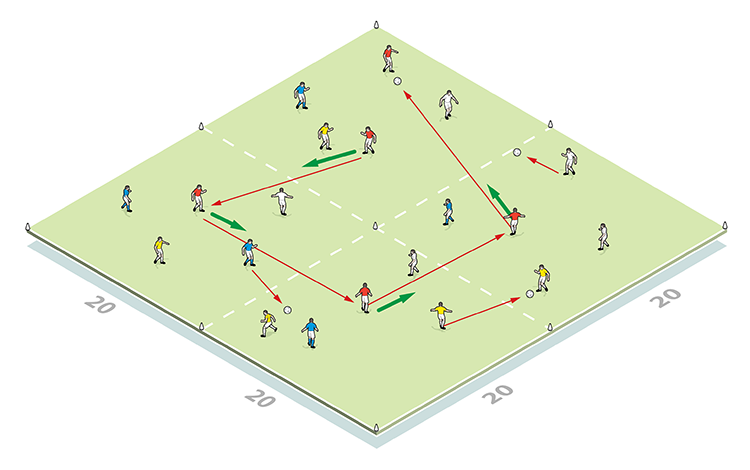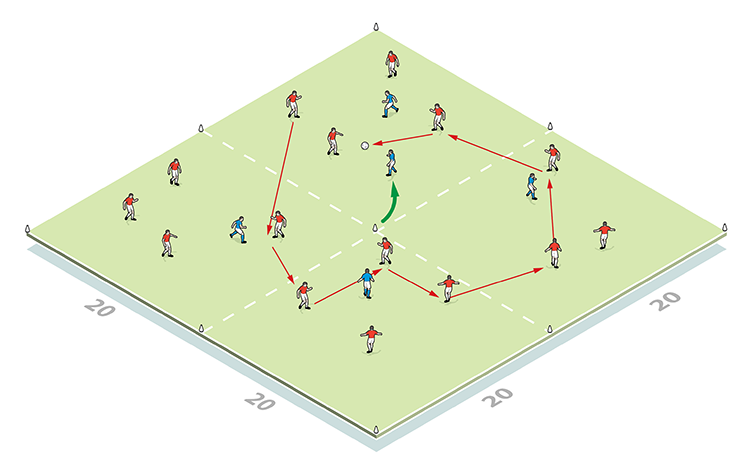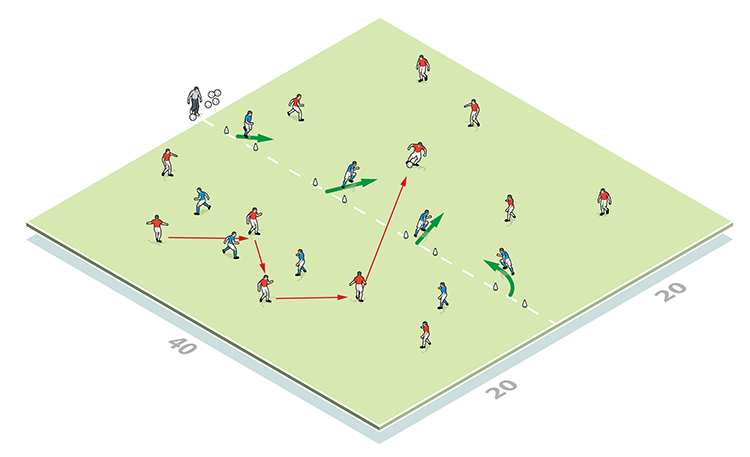Playing and receiving through the lines
This session is about passing and receiving through the lines of the opposition.

| Area | 40x40 yards |
| Equipment | Balls, bibs, cones |
| No. of Players | 20 |
| Session Time |
Box passing 10mins plus 5mins per progression, Directional practice 10mins, Gates 10mins, 10v10 game 20mins |
This session is about passing and receiving through the lines of the opposition.
It’s important to practise this because good passing obviously represents a core value of any club’s footballing philosophy, and particularly ours.
The skills that this approach play showcases can be utilised, harnessed and reused in every game, both when playing through the opposition and when passing amongst ourselves.
We’ll run this session fortnightly so the principles are always familiar to our players.
What do I get the players to do?
Box passing
We use 20 players – four teams of five players, each team with a ball. Players pass and follow in a clockwise direction at first, then anticlockwise (1). The focus for players is on playing through the bodies in front of them.
1

How do I progress the session?
Progressions increase the complexity of the passing patterns and the need for players to be aware of what’s around them. First, we progress so that two teams pass clockwise and two anticlockwise (2). Next, players receive and run with the ball whilst on the move, retaining the purpose of passing around the area.
2

Directional practice
Next we run a practice that’s 15v5. The five defenders are positioned one in each box plus a fifth floating player. They must stop the ball being passed around by tackling or intercepting (3). Play for 10 minutes, or until a set number of circulations have been achieved by the team in possession.
3

Gates game
This is 6v4 in each half - gates are five yards wide and spread across the halfway line. Can the team of six move the ball into the other half through the unguarded areas? When successful, the gate defenders now push into the opposition half and press the other group of six players (4).
4

The chasing defenders now replace their team mates in the gates (5). If defenders win the ball back, the coach restarts with the waiting team of six.
5

2. Non-working blues move forward to replace their team mates in the gates
3. Blues make an interception
10v10 game
Finally, we move to a 10v10 game in the space between the two penalty boxes. One team plays 4-4-2, the other 4-3-3. In possession, teams must use the overloads practised earlier to work the ball through opposition players. Both teams out of possession should attempt to press whilst retaining their designated shape.

What are the key things to look out for?
The emphasis is on the weight of the pass and the body position of players receiving the ball, always looking for an angle to keep play moving. Awareness and movement are essential components.
Editor's Picks
Attacking transitions
Deep runs in the final third
Using the goalkeeper in build-up play
Intensive boxes drill with goals
Penetrating the final third
Creating and finishing
My philosophy
Pressing initiation
Compact team movement
Coaches' Testimonials

Alan Pardew

Arsène Wenger

Brendan Rodgers

Carlos Carvalhal

José Mourinho

Jürgen Klopp

Pep Guardiola

Roy Hodgson

Sir Alex Ferguson

Steven Gerrard
Coaches' Testimonials

Gerald Kearney, Downtown Las Vegas Soccer Club

Paul Butler, Florida, USA

Rick Shields, Springboro, USA

Tony Green, Pierrefonds Titans, Quebec, Canada
Join the world's leading coaches and managers and discover for yourself one of the best kept secrets in coaching. No other training tool on the planet is written or read by the calibre of names you’ll find in Elite Soccer.
In a recent survey 92% of subscribers said Elite Soccer makes them more confident, 89% said it makes them a more effective coach and 91% said it makes them more inspired.
Get Monthly Inspiration
All the latest techniques and approaches
Since 2010 Elite Soccer has given subscribers exclusive insight into the training ground practices of the world’s best coaches. Published in partnership with the League Managers Association we have unparalleled access to the leading lights in the English leagues, as well as a host of international managers.
Elite Soccer exclusively features sessions written by the coaches themselves. There are no observed sessions and no sessions “in the style of”, just first-hand advice delivered direct to you from the coach.









